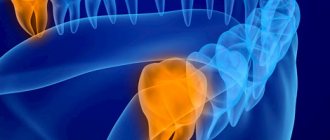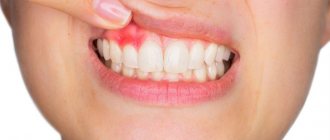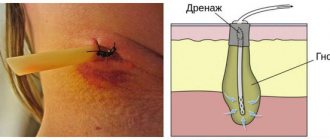A periodontal abscess is an acute purulent inflammation of the gums. A complex pathology in which a purulent sac forms inside the periodontium, which in size can reach the size of a walnut. When a bladder filled with purulent contents ruptures, blood poisoning can occur and the infection can spread throughout the body. That is why it is important to promptly seek help from a specialist who will diagnose the disease, prescribe adequate treatment and prevent relapses.
What is a gum abscess, definition of the disease
Let us consider in more detail what an abscess on the gum is and the mechanism of its occurrence. A purulent focus occurs as a result of long-term untreated inflammation of periodontal tissues. The pathogenesis of the disease is associated with the penetration of pathogenic microorganisms (mainly Bacteroides forsythus and Porphyromonas gingivalis) into the periodontal tissues. Possible routes of penetration of microbes:
- from the outside: through a carious cavity, chips, cracks on the surface of the segment;
- from the inside (hematogenously, lymphogenously): in the presence of other septic foci in the body.
During their life, bacteria produce toxic substances that lyse tissue cells, resulting in the formation of a cavity filled with pus. The abscess under the tooth is surrounded by a connective tissue capsule, which separates it from the intact periodontal tissues.
Microbial metabolic products have a neurotoxic effect on nerve receptors located in the pulp of the segment, which causes pain. In addition, they increase the permeability of the capillary walls, resulting in swelling of the surrounding tissues.
Causes of gum abscess
The human oral cavity contains about 30 strains of microorganisms, represented by more than 700 species of bacteria. Under normal conditions, microbiocenosis does not harm its owner. A dental abscess occurs only in the presence of certain factors:
- traumatic disruption of the periodontal junction;
- infectious dentogingival pathologies;
- transmission of microorganisms through the bloodstream from other infectious foci (meningitis, pneumonia, tonsillitis, etc.);
- gum damage during segment therapy;
- trauma to the crown or root of the unit;
- peri-implantitis (inflammation around the implanted tooth root).
The likelihood of developing the disease increases with poor oral care, hypothermia, accumulation of tartar inside deep periodontal pockets, and smoking. Professional hygiene and gum treatment in Moscow is carried out by doctors of the North-Eastern Dental Center No. 1. A timely visit to the clinic will reduce the risk of the formation of a purulent formation.
What causes an exacerbation?
Periodontium is a dental support system. Thanks to this system, the roots of the teeth remain attached to the jaw bones. A periodontal abscess develops due to infection in the gum pockets and damage to the dental epithelial attachment. And:
- Gingivitis, periodontal disease, periodontitis;
- Insufficient oral hygiene. It is important to thoroughly brush your teeth twice a day, using not only a toothbrush, but also floss;
- Low immunity, chemotherapy;
- Food preferences: frequent consumption of sweets, starch, carbonated drinks leads to disorders due to which gum tissue and teeth have to be saved;
- Caries and pulpitis;
- Getting food debris or a foreign body into the gingival pocket, injury from bone fragments, a toothpick, or overhanging edges of the filling material.
There are chronic and acute stages of abscess. Determined by the dentist during a visual examination of the oral cavity. If the abscess is large and the gums are inflamed, an X-ray examination is prescribed. An x-ray will show how far the inflammation has spread and whether there is damage to the bone tissue.
Symptoms of gum abscess
Gingival abscess manifests itself in two types of symptoms: local and general clinical. Local symptoms are caused by reactive manifestations in the area of inflammation. The appearance of general symptoms is associated with intoxication of the body. The main symptomatic manifestations of the disease:
| Local inflammatory reaction | Symptoms of intoxication |
| pain when pressing on the affected unit; hyperemia of the gums over the area of inflammation; swelling of the tissue around the abscess; smell of rot from the mouth; violation of facial configuration; formation of a tubercle with purulent contents near the tooth; increased mobility of the diseased unit; darkening of tooth enamel; enlargement of nearby lymph nodes. | hyperthermia; dyspnea; cranialgia; violation of orientation in space; tachycardia; aching joints; lethargy; drowsiness; irritability. |
The leading symptom of an abscess is pain. It can be fixed only at the point of inflammation, but more often the discomfort radiates to the head, auricle, eye socket, neck, and neighboring segments. Soreness has different intensity, character (sharp, shooting, dull), occurs periodically in response to stress factors, or is constantly present.
How a surgical autopsy is performed
Surgical opening (periostomy) can be complicated by the general condition of the patient and the size of the tumor. In some cases, it reaches such a size that it requires the installation of a drainage, a small tube that facilitates the outflow of purulent contents from the pocket. After opening such tumors, due to long-term suppression of the immune system, the patient is prescribed not only antibacterial drugs, but also immunostimulating therapy.
To avoid complications after surgery, dentists recommend their patients:
- refrain from smoking, drinking alcohol, and excessive food consumption;
- do not abuse sleeping pills and laxatives;
- do not take strong painkillers unless absolutely necessary;
- if the condition worsens, namely an increase in body temperature, the appearance of pus, redness around the incision, increased pain, incl. headache, muscle pain, immediately seek help from a doctor.
Stages of development and classification of gum abscess
A gum abscess most often has an acute course, characterized by a clear clinical picture with increasing pain and swelling. Sometimes, in the absence of treatment, the process may subside, the clinic becomes weakly expressed and erased. This means that the abscess has become chronic.
Depending on the location of the purulent focus, several types of pathology are distinguished:
- Periodontal abscess. Localized inside the hypertrophied periodontal pocket (between the alveolar process and the gum). The cause of the pathology is subgingival deposits, which are a breeding ground for the proliferation of bacteria.
- Periapical (root). The leading cause of occurrence is inadequate root canal treatment, leading to periodontal inflammation. Granulations form near the root apex. Progressive inflammation spreads to the periosteum and periodontal tissue. A connective tissue capsule with purulent contents is formed. Over time, a fistula forms with pus coming to the surface in the form of a lump.
- Desnevoy. The purulent cavity is located near the papillae between the segments. A possible cause is an injection into the gum.
Main forms of periodontal abscesses
- Acute – characterized by pronounced clinical manifestations and a sharp increase in pain. Deep periodontal pockets are diagnosed in the oral cavity, individual teeth become mobile, and the person feels a general malaise.
- Chronic – the disease occurs with “erased” symptoms. The gums begin to bleed, the ulcers become more voluminous and dense, and the roots of the teeth become exposed.
Note! Sometimes a periodontal abscess may go away on its own, but this does not mean that the patient has cured on their own. The process can become chronic, poisoning the body with decay products of soft tissues.
Depending on the location of the purulent sac, the following types of abscesses are distinguished:
- basal;
- apical;
- cervical.
Stages of development of gum abscess
| Disease stage | Description |
| Initial | The beginning of inflammation. If the immune system is functioning well, the process may stop on its own. Symptoms are absent or mild. If the immune defense is insufficient, bone or soft tissue begins to melt. Hyperemia of the mucous membrane and discomfort appear. |
| Subacute | The inflammatory process intensifies. Pus accumulates in the pathological area (near the root, inside the periodontal pocket, near the gingival papilla). The pain intensifies. The tooth reacts to irritation. |
| Acute | Progression leads to abscess formation: a cavity with pus forms in the central zone of infiltration. The clinical picture is clearly expressed: the pain is constant, sharp, swelling appears. A lump appears on the surface of the gum, inside of which there is purulent exudate. Inflammation spreads to the submandibular lymph nodes. |
| Chronic | The abscess on the gum spontaneously opens and the contents of the cavity come out. Signs of acute inflammation subside. |
Diagnosis of the disease
At the initial stage of diagnosis, the dentist-therapist performs a visual examination with palpation of the inflamed area. In order to determine what other structures are affected, X-ray and laboratory examinations are performed. An appropriate examination allows us to establish the localization of the purulent sac; it can be cervical, apical, or hilar. Laboratory analysis helps to identify markers of infection and determine the type of pathogen. Digital X-ray diagnostics allows you to determine whether the inflammatory process has reached the bone tissue, this will help to understand whether surgical treatment is required for periodontal abscess.
In accordance with the data obtained from the anamnesis and x-ray, a cytological examination of the salivary fluid may be required. The latter makes it possible to identify the number of damaged granulocytes. In case of suppuration in the area of the dental system and osteomyelitis, the help of a dental surgeon may be required. In each specific case, consultation with an experienced specialist is necessary in order to establish the clinical picture as accurately as possible and determine a scheme for endodontic treatment or surgical intervention.
Complications that a gum abscess can cause
Without treatment of the disease and inadequate medical care, complications may develop. Adverse consequences arise due to the spread of inflammation to neighboring organs and tissues, as well as the spread of infection throughout the body with the formation of secondary septic foci. The most common pathological conditions that occur are:
- lymphadenitis - infection of the lymph nodes;
- sinusitis - infection in the maxillary sinuses;
- periostitis of the jaw (inflammation of the periosteum);
- osteomyelitis of the jaw bones (destruction of bone tissue due to purulent-necrotic melting of osteocytes);
- phlegmon - diffuse odontogenic inflammation of soft tissues, accompanied by progressive swelling of the face;
- destruction of the alveolar processes with significant loosening of teeth or their loss;
- peri-implantitis with implant rejection;
- sepsis.
Purulent lesions of soft periodontal tissues are always accompanied by general intoxication of the body. The temperature rises and chills appear. There is a headache, tachycardia, and the pulse quickens. Pain relief with medications brings short-term relief, but symptoms return after the medication wears off.
First aid
- Before visiting the dentist, you can take painkillers to reduce pain: Paracetamol, Nurofen.
- It is recommended to rinse the mouth with antiseptic solutions: furatsilin, potassium permanganate.
- It is forbidden to squeeze out the abscess, as well as use any thermal procedures in the area of the abscess: compresses, heating pads, as this can lead to the spread of the purulent process.
- In case of intoxication (fever, headache), it is necessary to increase the drinking regime to 2.5–3 liters per day.
Treatment of gum abscess
Treatment of the disease is aimed at solving two main problems:
| Type of treatment | Methods |
| Symptomatic treatment of inflammation and pain syndrome | removal of an abscess on the gum (dissection, installation of drainage for the outflow of pus); antibiotic therapy (penicillins, fluoroquinolones, macrolides). Prescribed to stop the infectious process; NSAIDs (Diclofenac, Indomethacin, Ibuprofen, etc.). Eliminate pain and inflammation; antiseptics (Chlorhexidine, Miramistin). Used in the form of rinses and gum baths for antiseptic treatment of the oral cavity. |
| Etiotropic treatment (elimination of the cause of pathology) | tooth extraction. Carry out when it is impossible to implement tooth-preserving measures; repeated endodontic treatment (opening of canals and their refilling); professional teeth cleaning to remove mineral and soft plaque; removal of the artificial root (for peri-implantitis). |
An abscess on the gum is a serious dental pathology. If treatment is not started in time, the process continues to develop and leads to adverse consequences. To avoid complications, at the first signs of inflammation you should make an appointment with the dentist. ]dentistry in Otradnoye[/anchor] offers assistance in eliminating problems with diseased teeth and periodontal disease.
Causes of development of purulent periodontal inflammation
Ignoring brushing and rinsing your teeth after eating only contributes to the development of pathological microflora, which subsequently leads to the appearance of periodontal disease, gingivitis, and periodontitis. Next, a gum pocket is formed, which is filled with pus and an abscess is formed.
Important!
By contacting the dentist at the first sign of gum disease (bleeding, redness, sensitivity) you will save time and money. By postponing a visit to the doctor, you are dooming yourself to unnecessary expenses and dooming your teeth to decay, which can be stopped with timely treatment.
In addition to poor hygiene, the development of periodontal abscess is facilitated by:
- mechanical periodontal injuries (a bone from a fruit or fish, a scratch with a fork);
- burn. We are not talking about “swallowing fire”; a hot drink is enough for an abscess to begin to develop on the weakened mucosal tissue;
- the habit of “grinding” your teeth, closing them tightly;
- crooked bite and deformed teeth.
To be fair, we note that 1% of the development of purulent inflammation of the subgingival pocket is the fault of unprofessional dentists. During mechanical cleaning or treatment of the tooth, the affected surface of the mucous membrane was not disinfected.










